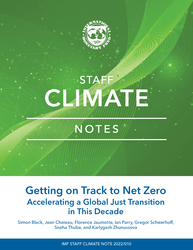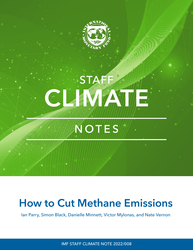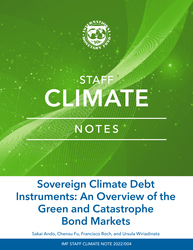
Getting on Track to Net Zero: Accelerating a Global Just Transition in This Decade
To contain global warming to between 2°C and 1.5°C, global greenhouse gas emissions must be cut 25 to 50 percent below 2019 levels by 2030. This Note presents illustrative options for closing this ambition gap equitably and discusses their economic impacts across countries.
READ MORE...
Volume/Issue:
Volume 2022
Issue 010
Publication date: November 2022
ISBN: 9798400223877
$5.00
Add to Cart by clicking price of the language and format you'd like to purchase
Available Languages and Formats
| English |
Prices in red indicate formats that are not yet available but are forthcoming.
Topics covered in this book
This title contains information about the following subjects.
Click on a subject if you would like to see other titles with the same subjects.
Economics- Macroeconomics , Economics / General , Environmental Economics , Environmental Conservation and Protection , Public Policy- Environmental Policy , Climate change mitigation , ambition gap , policy gap , mitigation pledges , differentiated responsibilities , abatement costs , welfare costs , GDP , burden sharing , carbon pricing , climate finance , IMF staff climate note , abatement cost , welfare cost , climate benefit , IMF staff climate Note 2022/010 , Greenhouse gas emissions , Climate change , Climate policy , Global , Africa , Eastern Europe , East Asia , Caribbean
Summary
To contain global warming to between 2°C and 1.5°C, global greenhouse gas emissions must be cut 25 to 50 percent below 2019 levels by 2030. Even if fully achieved, current country pledges would cut global emissions by just 11 percent. This Note presents illustrative options for closing this ambition gap equitably and discusses their economic impacts across countries. Options exist to accelerate a global just transition in this decade, involving greater emission reductions by high-income countries and climate finance, but further delays in climate action would put 1.5°C beyond reach. Global abatement costs remain low under 2°C-consistent scenarios, with burdens rising with income levels. With efficient policies of carbon pricing with productive revenue use, welfare costs become negative when including domestic environmental co-benefits, before even counting climate benefits. GDP effects from global decarbonization remain uncertain, but modeling suggests they exceed abatement costs especially for carbon-intensive and fossil-fuel-exporting countries. Ratcheting up climate finance can help make global decarbonization efforts more progressive.
Copyright © 2010 - 2026
Powered by:
AIDC



